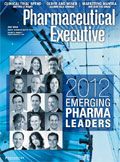Less, But Better
Pharmaceutical Executive
Pharm Exec's 2012 roster of Emerging Leaders-our sixth to date-is not only a way to recognize a few individuals who've made a difference in their organizations. It also serves as a barometer to track larger changes in the workplace.
PHARM EXEC'S 2012 ROSTER OF EMERGING LEADERS—our sixth to date—is not only a way to recognize a few individuals who've made a difference in their organizations. It also serves as a barometer to track larger changes in the workplace: how work is done; who does it; where, and with what range of skills; and for what outcome or objective. With the support of Pharm Exec's Editorial Advisory Board, we've selected 15 executives drawn from a range of mission-critical functions, varied geographies, and diverse gender and cultural characteristics. Together, they symbolize the sweeping changes industry is undergoing, from an era where growth was the assumed baseline for all management decisions to a future of lower margins and bitterly contested market share.

William Looney
Pfizer has captured these emerging facts of life in a startling new missive to its 103,000 employees: "do less with less." Apologies to the communications team, but we might suggest a more inspiring alternative, drawn from the life's work of German design guru Dieter Rams: "Weniger, aber besser"—Less, but better." Central to this idea is that which is spare and scarce will always reveal its essence—what is pure and true and fundamental. It follows that the freshest ideas can spring from austerity. There is nothing like a frayed business model to concentrate the mind.
The 15 profiles compiled by our editorial team is reference in itself to the trends and values that will shape strategy in biopharmaceuticals for the remainder of the decade. Some of the more interesting insights:
The real meaning of "lean." As companies scale back, the response is not just to "do more with less." All agree that the change is strategic, not temporary, and relates squarely to the higher long-term risk profile of the business. The optimal response to the lean agenda is to contribute to strengthening the efficiency of business practice; sometimes this requires more resources, not less. Making trust, engagement, and loyalty programs really convincing to employees is another necessary leadership attribute of a lean organization, where the impact of a loss of any productive worker is magnified.
Information is now borderless, posing a significant management challenge to stronger employee engagement. Rapid improvements in IT technologies are forcing leaders to be more transparent, requiring in turn a commitment to making information verifiable to employees and team members. Tomorrow's business leaders must be able to certify and validate reams of unsubstantiated information.
The key emotional chord in today's pharma workplace is to convey a sense of urgency. Time and space for action are compressing due to the impact of improvements in technology, accessibility of information, the globalization of competition, and a changing demographic of the market base. Complacency is a trait associated with older forms of organization linked to hierarchical decision-making and a command and control leadership style, where the prudent response for anyone with leadership aspirations was to defer and deliberate. That old strategy remains an option—old habits die hard, particularly the bigger the organization is—but fewer of those raised in the Internet age of instant access to information laced with opinion are likely to embrace it.
The talent pipeline is spouting in a different direction. Under previous generations, drug research and other good ideas germinated in "mature" markets, preferably the home office, with production and secondary services devolved to low-income countries. Looking forward, that pattern may well be reversed, which requires the ability to initiate, analyze, and execute around a global approach that can accommodate diverse cultures and perspectives on doing business. Do we know that some Asian languages don't have a definitive equivalent to the simple word "no"?
The real driver of "human resources" is the power of the personal connection. The tendency in Big Pharma has been to do precisely the opposite, turning the HR function into an information processing service that takes place mainly online. Many of our leaders urged that management restore what is "human" about human resources, through a renewed emphasis on counseling and support for "soft" skills like leadership training, talent development, and mentoring.
The best innovations are often a consequence of a workplace failure. A repeated theme in the interviews is that good organizations impose no sanctions on failure. Making mistakes is "part of the job," and what counts is a willingness to reach beyond a presumed outcome to try something new. Management will need that approach to navigate through changes that are becoming harder to account for in advance.
William Looney
Editor-in-Chief
Follow Bill on Twitter: @BillPharmExec

Addressing Disparities in Psoriasis Trials: Takeda's Strategies for Inclusivity in Clinical Research
April 14th 2025LaShell Robinson, Head of Global Feasibility and Trial Equity at Takeda, speaks about the company's strategies to engage patients in underrepresented populations in its phase III psoriasis trials.
Beyond the Prescription: Pharma's Role in Digital Health Conversations
April 1st 2025Join us for an insightful conversation with Jennifer Harakal, Head of Regulatory Affairs at Canopy Life Sciences, as we unpack the evolving intersection of social media and healthcare decisions. Discover how pharmaceutical companies can navigate regulatory challenges while meaningfully engaging with consumers in digital spaces. Jennifer shares expert strategies for responsible marketing, working with influencers, and creating educational content that bridges the gap between patients and healthcare providers. A must-listen for pharma marketers looking to build trust and compliance in today's social media landscape.
Pfizer, GSK Gain ACIP Recommendations for RSV and Meningococcal Vaccines
April 18th 2025The Centers for Disease Control and Prevention’s Advisory Committee on Immunization Practices voted to expand access to Pfizer’s respiratory syncytial virus vaccine Abrysvo for high-risk adults in their 50s and voted in favor of GSK’s meningococcal vaccine, Penmenvy, for streamlined adolescent protection.